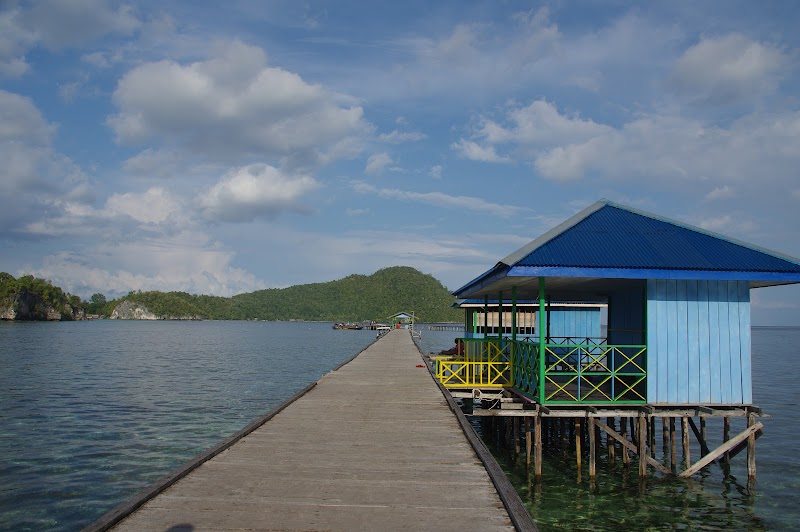Diving Into the Depths: Exploring the Underwater Marvels of Raja Ampat, Waisai
Discover the remarkable underwater world off Waisai in Indonesia’s Raja Ampat Islands, home to some of the most biodiverse coral reefs on the planet. From vibrant coral gardens to majestic manta rays, this marine wilderness offers an unforgettable mix of adventure and natural beauty for divers and snorkelers alike.
Choose Certified Dive Operators
Select dive centers with strong environmental practices and experienced guides to ensure safe and sustainable underwater experiences.
Pack Reef-Safe Sunscreen
Protect your skin and the fragile coral reefs by using biodegradable, reef-safe sunscreen to minimize environmental impact.
Stay Hydrated on Boat Trips
Bring plenty of water and stay hydrated throughout your day excursions as tropical heat and sun can be intense.
Practice Basic Drift Diving Skills
Many dive sites feature steady currents pushing divers along; mastering drift diving improves safety and enjoyment.
Diving Into the Depths: Exploring the Underwater Marvels of Raja Ampat, Waisai
Just off the coast of Waisai, in the heart of West Papua’s Raja Ampat Islands, lies a world where water breathes life into one of Earth’s richest underwater ecosystems. The coral reefs here don’t just sit quietly beneath the waves—they pulse with vibrant colors and darting life, daring the adventurous to explore. Every dive or snorkel reveals new layers: schools of multicolored fish weaving through ancient coral structures, sea turtles methodically gliding past, and the occasional curious reef shark patrolling the depths like a vigilant guardian.
Raja Ampat’s underwater realm covers a vast expanse of reef systems and channels, offering varied terrain from shallow coral gardens just meters below the surface to dramatic drop-offs plunging tens of meters deep. Those conditions attract divers and snorkelers of all skill levels. Visibility often exceeds 30 meters on clear days, and the water temperature hovers around a comfortable 28°C (82°F), making it ideal for extended dives.
Preparation here is practical: plan for multiple dives at different sites to fully appreciate the biodiversity. Popular spots like Cape Kri, with its record-setting fish diversity, and the eerie, beautifully photogenic Blue Magic dive site, bring the ocean’s fierce personality to life. Currents push and pull—always present, never overwhelming—so mastering basic drift diving skills will lift your experience.
Getting to these spots typically means taking a boat from Waisai, the region’s gateway town, where dive operators offer day trips or multi-day liveaboard options. Bringing reef-safe sunscreen is critical—Raja Ampat’s environment relies on delicate coral ecosystems that suffer under chemical exposure.
Snorkelers needn’t feel left out: the shallower reefs near Arborek Island provide spectacular encounters with manta rays and reef sharks, with less challenge but equal thrill. Remember to keep a keen eye—this is an ecosystem fiercely protective of itself, with hidden crevices and camouflaged creatures testing your attentiveness.
Whether you are a seasoned diver chasing encounters with rare critters or a curious snorkeler hungry for color and motion, Raja Ampat off Waisai offers an underwater adventure where nature’s complexity and power are laid bare, inviting respect and awe without pretense.
Nearby Trips
All Adventures
Boat Charters
Water Activities
Adventures near Waisai
Discover the unique and memorable adventures that make Waisai special.
Frequently Asked Questions
What level of diving certification do I need to dive in Raja Ampat?
Most dive sites off Waisai require at least an Open Water certification due to occasional currents. For drift diving spots, Advanced Open Water is recommended to safely navigate stronger flows.
Are there snorkeling options for non-divers?
Yes, there are excellent snorkel sites with shallow coral reefs where marine life is easily visible and accessible, such as near Arborek Island, ideal for all skill levels.
How do I get to the dive sites from Waisai?
Most dive operators in Waisai provide transport by boat to various dive sites. Day trips typically last 4–6 hours with 2-3 dives, while liveaboards offer extended access across the archipelago.
What marine animals can I expect to see?
Raja Ampat is famous for its fish diversity, reef sharks, manta rays, sea turtles, pygmy seahorses, and occasionally large pelagic species like hammerhead sharks and giant trevallies.
Is Raja Ampat environmentally protected?
Yes, much of Raja Ampat is part of marine protected areas with strict conservation rules to preserve coral reefs and marine biodiversity while supporting sustainable tourism.
Can I charge my diving equipment in Waisai?
Waisai has sufficient infrastructure including dive shops equipped with air fills and basic gear servicing. Some resorts also provide charging stations for batteries and dive lights.
Recommended Gear
Mask, Snorkel, and Fins
Quality gear ensures comfort and clarity for all snorkeling and diving activities in Raja Ampat’s rich waters.
Wetsuit (3mm to 5mm)
Water temperatures hover around 28°C but a wetsuit provides protection from sun, jellyfish, and minor abrasions.
Reef-Safe Sunscreen
Protects both your skin and the delicate coral ecosystems from harmful chemicals.
Underwater Camera or GoPro
Capture the dazzling marine life and landscapes with a waterproof camera suited for low-light underwater conditions.
Local Insights
Hidden Gems
- "Blue Magic dive site for rare encounters with large pelagics"
- "The lagoons near Mansuar Island known for pristine coral gardens"
- "Underwater caves around Fam Island that shelter unusual species"
Wildlife
- "Wobbegong sharks often rest on sandy bottoms"
- "Harlequin shrimp hiding among coral branches"
- "Sweetlips with changing patterns and spectacular colors"
History
"Raja Ampat’s islands are inhabited by indigenous Papuan communities whose culture integrates closely with the sea. Traditional fishing methods and folklore remain vital to local identity."

